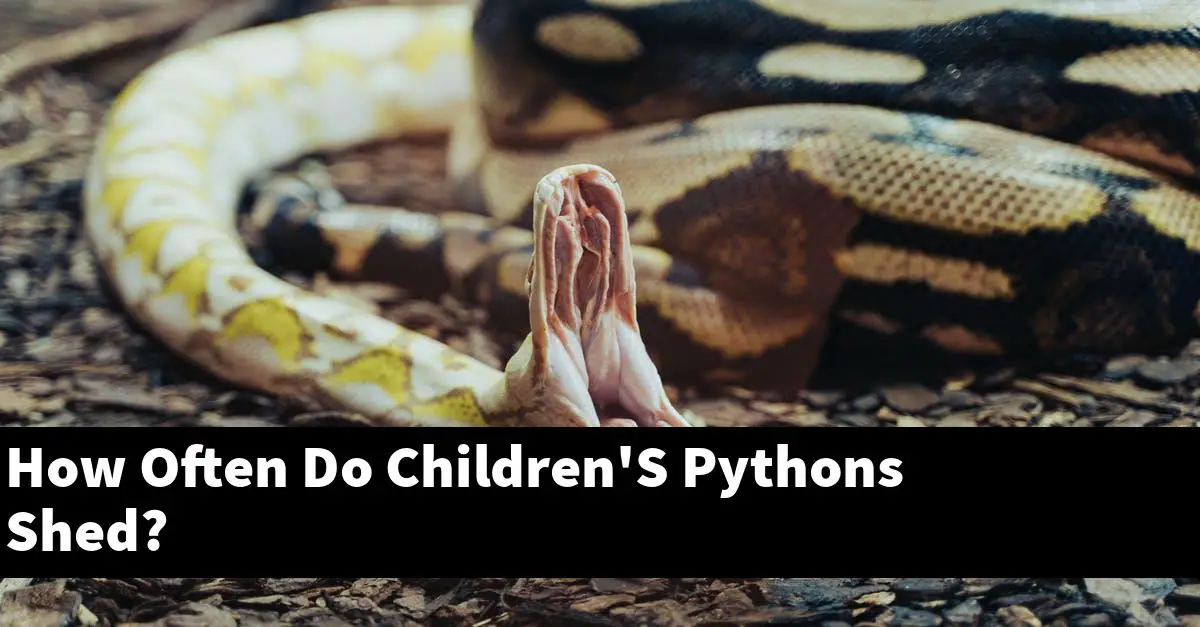Pythons are typically shed every two to six weeks, with children’s pythons on the lower end of that range.
The article covers the frequency of python shedding, how to tell when a python is going to shed, and the process of shedding.
Table of Contents
How often do children’s pythons shed their skin?
A children’s python will typically shed their skin every 4-6 weeks. The process of shedding usually takes about 3-4 days to complete.
What are some of the benefits of shedding children’s pythons?
Shedding is an important process for children’s pythons, as it helps them to get rid of old, damaged, or unwanted skin. This process can also help to prevent infection and keep the snake’s body healthy.
Some of the benefits of shedding include:
- Removing old and damaged skin: Shedding helps to remove old and damaged skin, which can help to prevent infection and keep the snake’s body healthy.
- Preventing infection: Shedding can help to prevent infection by keeping the snake’s skin healthy and free of bacteria.
- Keeping the snake’s body healthy: Shedding helps to keep the snake’s body healthy by removing old and damaged skin. This process can also help to prevent infection and keep the snake’s body healthy.
How can you tell when a children’s python is getting ready to shed?
When a children’s python is getting ready to shed, you will notice that the snake’s eyes will start to become cloudy and opaque. The snake will also start to refuse food, and become generally lethargic. You may also see the snake’s skin start to become dull and dry-looking. shedding usually occurs every 4 to 6 weeks, and the entire process can take up to two weeks.
What should you do to care for a children’s python during the shedding process?
When children’s python sheds, it is important to provide them with a warm, humid environment. This can be done by misting the enclosure with water or using a humidity box. It is also important to make sure that the python has access to a shallow dish of water so that they can soak if necessary.
During the shedding process, it is important to avoid handling the python as much as possible. If you must handle them, be sure to do so gently and carefully. Be sure to keep an eye on the python for any signs of stress or discomfort. If you see any of these signs, it is best to stop handling them and let them finish shedding in peace.
Is a Childrens Python a good beginner snake?
A Childrens Python is a great beginner snake for a few reasons. First, they are small and therefore easy to handle. Second, they are not as aggressive as some other snakes, making them less likely to bite. Third, they are relatively easy to care for, and fourth, they are relatively inexpensive.
How often should I feed a Childrens Python?
It is generally recommended to feed children’s pythons 2-3 times per week. However, some keepers opt to feed their snakes once a week.
Ultimately, it is important to keep an eye on your snake’s weight and condition and adjust the feeding schedule accordingly. For example, if your snake is looking a bit thin, you may want to increase the frequency of feedings. If your snake is looking a bit overweight, you may want to decrease the frequency of feedings.
How long does a Childrens Python live for?
A Childrens Python lives for an average of 20 years.
What do Baby Children’s Pythons eat?
In the wild, baby Children’s Pythons eat a variety of small animals including lizards, rodents, and birds. They will also consume eggs and carrion. In captivity, they should be offered appropriately sized prey items such as mice, rats, quail, and chicks.
Prey should be offered no more than the width of the snake at its widest point and should be dusted with a calcium powder supplement prior to feeding.
Summary
Children’s pythons typically shed every 4-6 weeks. The shedding process can take up to two weeks and is important for the snake’s health. During the shedding process, it is important to provide the snake with a warm, humid environment and to avoid handling them as much as possible.

